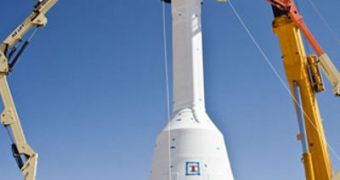Arguably the most important part of any spacecraft – as far as crew safety goes anyway – is the Launch Abort System. This is the mechanism that ensures astronauts stand most chances of survival in case something goes awry during the launch sequence, and when reaching orbit is no longer possible. As part of the seemingly-defunct Project Constellation, NASA developed the Orion Crew Exploration Module, which was supposed to carry an LAS aboard. Now turned into an unmanned escape vehicle, the Orion is still poised to receive its first test with the mounted LAS configuration today, May 6, Space reports.
Under US President Barack Obama's 2011 budget proposal, the American space agency is to cancel Constellation, and rather orient its fundings to supporting the private sector in developing alternatives for delivering astronauts to low-Earth orbit, and to the International Space Station (ISS). While the ARES I and ARES V delivery systems were canceled altogether, the Orion vehicle was stripped down from being the replacement for the shuttle fleet – due to retire this November – to functioning as an escape vehicle for ISS astronauts. It will basically have the same function as the Soyuz lifeboats that currently ensure the safety of the six-astronaut crew aboard the station.
The test scheduled to take place today will be oriented around seeing how the engines and thrusters that constitute the LAS function in real-life situations, not only on computer simulations. The procedures will take place today at the US Army's White Sands Missile Range, located near Las Cruces, in New Mexico. Calculations show that the LAS main thruster would fire with about 500,000 pounds of force, which means that any potential astronauts inside the capsule (in a real-life situation) would experience about the same amount of Gs as a jet fighter pilot ejecting during mid-flight.
“What we'll probably pull here is about 15 1/2 Gs, but because the astronauts would be laying back in their launch position they can take more than a jet fighter pilot can take,” explains Lockheed Martin Orion Program launch abort systems director, Roger McNamara. “They'll feel the effects. The bottom line is they'll be walking away,” he adds, admitting that the astronauts may get injured in the process. However, they will be left alive, he emphasizes.

 14 DAY TRIAL //
14 DAY TRIAL //